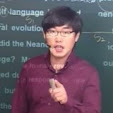All right, let’s start lesson no. 2. The second sentence structure is “S가 ~하면서 V합니다.”, which means “~ing ~, S V ~”. As you can see, ‘~ing’ is ‘participial construction’, that is to say, ‘doing something, somebody does something else at the same time’, right? So, ~하면서 is participial construction, and ‘S가 V합니다’ is the main clause.
OK, the schematic diagram is as follows.
아이들이 즐겁게 노래하면서 거리를 걸어갑니다.
Singing merrily, children are walking on the street.
아이들 is the subject of this sentence, and 이 is the subjective case. And 즐겁게 is an adverb, which means ‘merrily’, and 노래하면서 is participial construction, which means ‘singing’, so 즐겁게 노래하면서 is ‘singing merrily’, right? And 거리를 is ‘on the street’, and 걸어갑니다 is the verb of this sentence, meaning ‘walking’. So, 아이들이 즐겁게 노래하면서 거리를 걸어갑니다.
Singing merrily, children are walking on the street.
2. 나의 아들은 보통 음악을 들으면서 공부합니다.
Listening to the music, my son usually studies.
나의 is ‘my’, and 아들 is ‘son’, so 나의 아들 is the subject of this sentence, and 은 is the subjective case. And 보통 is an adverb, which means ‘usually’, and 음악 is ‘music’, and 들으면서 is participial construction, which means ‘listening’, so 음악을 들으면서 is ‘listening to the music’, right? And 공부합니다 is the verb of this sentence, meaning ‘to study’. So, 나의 아들은 보통 음악을 들으면서 공부합니다.
Listening to the music, my son usually studies.
3. 나의 딸은 아침을 먹으면서 TV를 봅니다.
Eating breakfast, my daughter watches TV shows.
나의 is ‘my’, and 딸 is ‘daughter’, so 나의 딸 is the subject of this sentence, and 은 is the subjective case. And 아침 is actually, morning, and 식사 is ‘a meal’, but we Koreans use 아침 rather than 아침식사, which means 아침 is also used as shortened form of 아침식사, breakfast, right?, and 을 is the objective case. And 먹으면서 is participial construction, which means ‘eating’, so 아침을 먹으면서 is ‘eating breakfast’, right? And TV를 is the object of the verb, 봅니다.
봅니다 is the verb of this sentence, meaning ‘to watch’. So, 나의 딸은 아침을 먹으면서 TV를 봅니다.
Eating breakfast, my daughter watches TV shows.
4. 그녀는 바람소리를 들으면서 오랫동안 앉아 있었습니다.
Listening to the sound of the wind, she sat for a long time.
그녀는 is the subject of this sentence, and 바람 is ‘wind’, and 소리 is ‘sound’, so 바람소리 is ‘the sound of the wind’, and 들으면서 is participial construction, which means ‘listening’, so 바람소리를 들으면서 is ‘listening to the sound of the wind’, right? And 오랫동안 is a kind of adverb, which means ‘for a long time’ And 앉아 있었습니다 is the verb of this sentence, meaning ‘to sit’. But 앉다 is the present tense. And 앉았다, or 앉아 있었다 is the past tense form. So, 그녀는 바람소리를 들으면서 오랫동안 앉아 있었습니다.
Listening to the sound of the wind, she sat for a long time.
5. 사람들이 이야기하고 와인을 마시면서 정원에 앉아 있습니다.
Chatting and drinking wine, people are sitting in the garden.
사람 is ‘person’, and 들 is plural, so 사람들 is ‘people’, right?
And 이 is the subjective case. So, 사람들이 is the subject of this sentence, and there are two participial constructions in this sentence, that is to say, 이야기하면서, and 마시면서, but when we combine these two words, we express like this, 이야기하고 마시면서. You can see the letter ‘고’ in this phrase, 이야기하고 마시면서, right? This 고 means ‘and’. 와인 is written as it sounds in English, and 을 is the objective case, and is the object of the verb 마시면서. By the way, 이야기하다 is ‘to chat’, and 마시다 is ‘to drink’. So, 이야기하고 와인을 마시면서 is ‘chatting and drinking wine’, right?
And 정원 is ‘garden’, and 에 is ‘in’, so 정원에 is ‘in the garden’, and 앉아 있습니다 is the verb of this sentence, and its meaning is ‘to sit’. So, 사람들이 이야기하고 와인을 마시면서 정원에 앉아 있습니다.
Chatting and drinking wine, people are sitting in the garden.







0 Comments